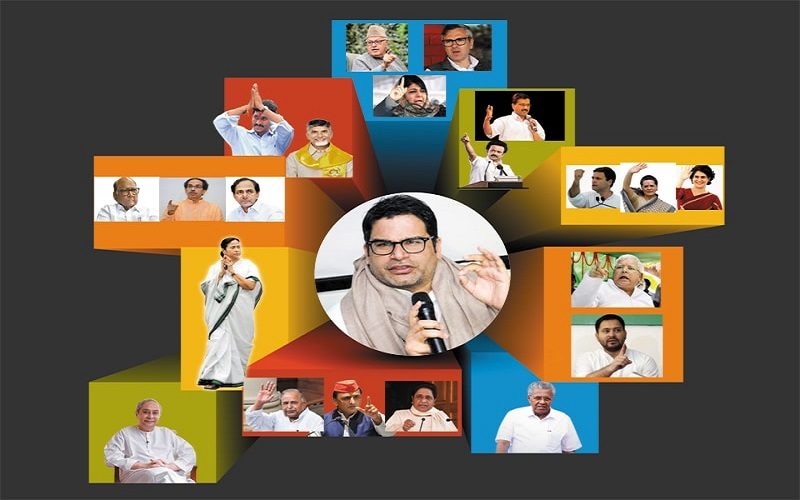Written by : Pratip Chattopadhyay
The assembly election of West Bengal in 2021 turned out to be a great deception for the Bharatiya Janata Party (BJP) and its supporters. The Trinamul Congress (TMC), the ruling party recorded a thumping victory with 213 seats out of 292 seats in which polls were conducted. The result of the election came out as a replay of the Delhi assembly election last year. In the immediate post-election phase, we witnessed a spate of violence among the rival party members at the grass root level, then conundrum over arrest, re-arrest and finally bail of two important cabinet rank ministers of the state government and one Member of Legislative Assembly (MLA) from TMC in relation with Narada scam of accepting money on camera among many others in 2014. Interestingly, the most prominent turncoat from TMC to BJP and now the opposition leader of the assembly Suvendhu Adhikari, despite being another prime accused in Narada scam was not arrested. Even the Supreme Court of India rebuked the Central Bureau of Investigation (CBI) for its dubious role in arresting those leaders amidst the second wave of coronavirus pandemic. Moreover, one of the arrested ministers is also holding the portfolio of interim mayor of Kolkata Corporation and is the head of the coronavirus task force.
The situation further aggravated during the Prime Minister’s visit in West Bengal aftermath of cyclone Yaas which ravaged a large part of upper eastern coastal area. The animosity between the central and the state administrations resulted in a controversy over non respect of official protocol alleged by both sides against each other. An administrative notice was served to the state’s chief secretary Alapan Bandopadhyay to report to central personnel office in New Delhi on day of his retirement, although he was having a prior three months extension in the same post by the centre taking into account of ongoing health crisis. The multitude of events attracted a lot of media gaze as well. These developments led TMC party and its government to criticize the vendetta approach of central government in connivance with the Governor of the state who has appeared more and more partisan than a neural institutional head.
The equilibrium in the federal relationship has waned further with the central government’s contested vaccination policy for its lack of transparency on the role of the state government in the whole process coupled with inflation of essential commodities like petrol, LPG cylinders and cooking oil. On the other hand, a number of cases of fraudulent vaccination camps organised in different parts of West Bengal by some scammers having close relation with the high authorities have given the right ammunition in the hands of BJP leadership to underline the rampant corruption existing in the state institutions.
In this context the present piece tries to reflect on various elements, both latent and manifest, that the elections of West Bengal gave meaning to the wider debates of Indian politics.
In mid 2021 assembly elections happened in four federal units – Assam, Tamil Nadu, Kerala and West Bengal and in one Union Territory- Puduchery. The elections took place in the midst of new found aspiration of BJP to ‘regain’ Assam and ‘win’ other federal units. The approach to ‘win’ was mostly concentrated in West Bengal to bring about ‘actual change’ or ‘asol poriborton’. Close to the assembly elections this year, a large section of important Trinamul Congress leaders changed sides to join BJP. Charged up by their presence, BJP dreamt to defeat TMC (government and party in power) by the TMC (recent defectors) and the entire central BJP leadership dictated the electoral play from New Delhi. The atmosphere was one of coming to power both among the party-in-power (Trinamul Congress) and party-in-wait-to-come-to-power (BJP) even before the election results are out.
Plunging a bit deep into the election milieu in West Bengal three specific points of interest appear:
(a) the behavior of party-in-power as an opposition : Trinamul Congress, which came to power in 2011 historically by defeating a continuous three and a half decade rule of Left political parties, seemed utterly unnerved as the election was progressing. For a party in power for ten odd years, it is quite embarrassing to see reports coming that they could not find booth agents in some places and in others their booth agents were threatened to stay home by the opposition, i.e. BJP. From its part, Trinamul Congress blamed the Election Commission of India and related central armed forces which ipso facto became the in-charge of law and order situation during election in the state, for being tilted in favour of the BJP. The Chief Minister, Trinamul Congress supremo Mamata Banerjee translated an accident as a conspiracy and continued the month long eight phase election campaign with a plastered ankle and in a wheel chair to put forth an imagery of stiff resistance capacity against the opposition onslaught inclusive of allegations of phone tapping, corruption and nepotism charges to charges of crafty showmanship.
(b) the narrative of cultural renaissance in the light of Hinduism : BJP tried to create a narrative of cultural renaissance in the state having their campaign tagline as an effort to rebuild ‘Sonar Bangla’ or the golden era of Bengal. The constituents of such a project ranged from promise of providing citizenship once and for all to Matua community (a 17% Hindu population of West Bengal who came from Bangladesh after partition but yet to have permanent citizenship of India) to promise of industrialization and health infrastructure betterment. BJP tried to push Trinamul Congress into back foot on the question of minority appeasement at the cost of neglecting the demands and aspiration of majority Hindus in the state in order to have Hindu vote consolidation in the state.
(c) selling the dream of development : from a vote on ‘Yes Mamata, No Mamata’ to a vote on ‘Yes Modi, No Modi’ – any assembly election is actually a mechanism of renewal of trust or breakaway of trust from the government in power. In that perspective, the West assembly election 2021, as in the past, must have been a test for Mamata Banerjee and her government’s performance over the last five years. On the contrary in actual electoral field, the battle was more about central government’s social welfare programmes and its effect versus the state government programs and its effect. Bemoaning the poor fate of the citizens of West Bengal, BJP urged the electorate to bring in BJP government thereby creating a ‘double-engine’ government (same government both at centre and state level) to ensure proper smooth flow of development of all sectors of society under the capable leadership of Prime Minister Narendra Modi. So ultimately the election became a kind of referendum on the attractiveness and usefulness of BJP’s schema of ‘double-engine’ government, some kind of pro-Modi or anti-Modi vote.
As the election result unfolded, BJP’s dream of ‘regaining’ Assam was achieved but ‘winning’ other federal units was shattered. At the national level among the five voting scene, BJP came to power in two – Puducherry and Assam, Left retained one – Kerala, and regional forces antithetical to BJP bagged two – DMK in Tamil Nadu and Trinamul Congress in West Bengal. Around the same time (mid-April) defeat of BJP in local level elections was recorded in two states which they are ruling – Uttar Pradesh and Tripura.
In West Bengal although BJP substantially increased their seats from 3 in 2016 to 77 in 2021, they remained far away from their actual goal of coming to power. In another interesting development, the West Bengal assembly for the first time since independence is bereft of any left and Congress representatives, a development that needs to be noted. The main defeat of BJP in West Bengal actually took place at the cultural level – the incident of firing by central police forces at Shitalkuchi in North Bengal on poll day created a sense of fear among the minorities particularly, and the ‘didi, o didi’ casual utterance by Prime Minister Modi in an election rally addressing the Chef Minister was also not well received by the Bengali society that has a rich cultural heritage of accommodation and assimilation.
The broader implication of these results reflects a new emerging trend in Indian politics, which is that the onward electoral march of BJP can be halted. Going by the electoral upsurge of BJP in 2014 and 2019 national level elections, a BJP dominant hegemonic party-system logic was getting rooted in academic discourses. The question is why that system needs to be done away with. The answer again takes us back to the cultural psyche of Indian society which is of tolerance, pluralism, dialogue, anti-imperialism and non-violence and peaceful coexistence. BJP post 2014 is trying to reach their goal – starting from a Congress free India to an opposition free India. As a result they are hail bent to rewrite history and culture in their own terms.
Experiences of coalition since late 1980s in India gave us two models – (a) an unstable coalition era from 1989 to 1999, (b) a stable coalition era from 1999 to 2014. While in the first phase national and regional political parties were unaware of the art of managing coalitions, in the second phase regional political parties supported national political party on the basis of common minimum programme leading to successful NDA led by Bharatiya Janata Party (National Democratic Alliance) and UPA led by Indian National Congress (United Progressive Alliance.
In the contemporary period, a coalition era seems to be emerging with non-BJP conglomerations coming up in federal units. A third front type of umbrella alliance of non-BJP, non-Congress parties has failed during 2019 elections. It lacked imagination and looked more like a crowd of individualist political leaders without any common structures to bolster a viable alternative to a cult figure like Narendra Modi. Although INC won only 52 seats out of 542 seats in the parliament, merely 9.6%, but the party got 19.49% of total votes casted nationwide against 37.36% of BJP which secured 303 seats (55.9%). Therefore, clearly any regional party would ever match the Indian National Congress to claim itself the flag bearer of a third front to oust BJP from power.
The post-Covid situation has offered new spaces of experiments and experiences to be unlocked. In that direction, although Mahagathbandhan (Grand Alliance) incorporating Indian National Congress in November 2020 Bihar assembly polls failed to defeat the ruling coalition of JD(U)-BJP by a minimal margin of 10 seats but attracted critical acclaim from political circles.
However a peculiar characteristic of this coalition era would be the lack of bargaining style of regional political parties as seen in earlier coalition phase and it would be replaced by an ideology of secularism, accommodation and pluralism. This would be a long-drawn process of coming together of regional political forces keeping the Indian National Congress (even with their leadership and organizational crisis) to play the role of a fulcrum. Indian electorate after being tired of the bargaining politics of coalition resorted back to a stable single party government and hence the success story of BJP coming to power in consecutive to terms increasing their vote and seats every time at the national level in 2014 and 2019. So this present coalition era would be resistance politics of regional forces to prevent BJP from realizing its ideal of an opposition free India and prevent it from rewriting the cultural and historical imageries of the country.
The effort is underway by the initiative of election strategy specialist Prashant Kishor (PK) who is behind the win of TMC in West Bengal and many other opposition party hold states, ironically he is also one of the architects of Modi-Wave before 2014 general election. As per his declaration, he sees himself in a bigger role at the national level than remaining an election strategist. Results of West Bengal assembly elections 2021 is a stepping stone of a larger national political effect as India approaches its next general election in 2024 where accepting Indian National Congress’s fulcrum role by opposition parties will be a must to begin united coalition era.
(The views expressed in this article are the author’s own and do not necessarily reflect Multidimension’s editorial stance.)
About the author :
Pratip Chattopadhyay
Assistant Professor, Department of Political Science, University of Kalyani, West Bengal, India




